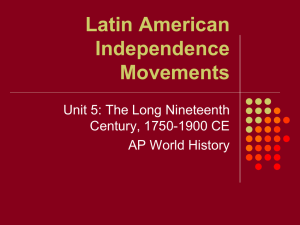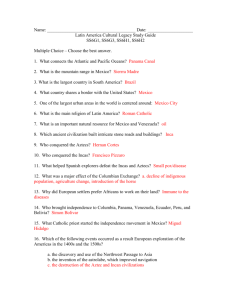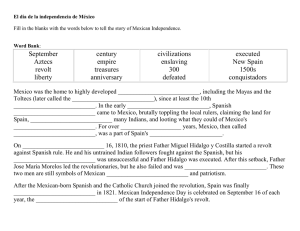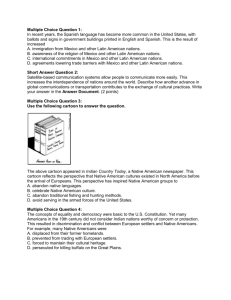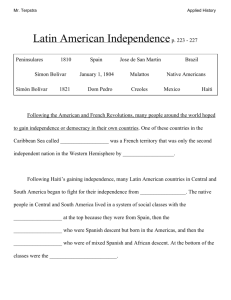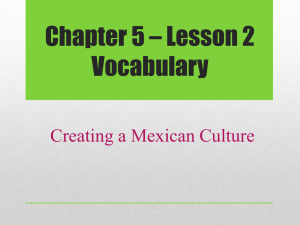Week 3, 4
advertisement
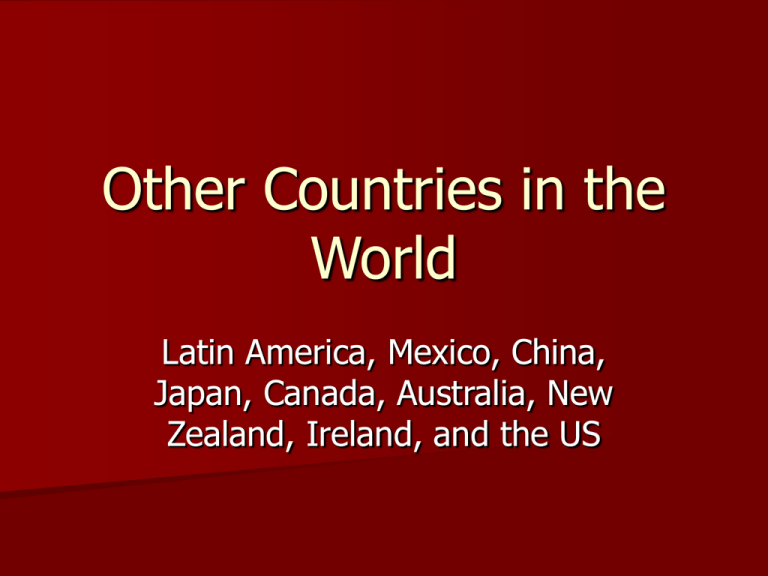
Other Countries in the World Latin America, Mexico, China, Japan, Canada, Australia, New Zealand, Ireland, and the US Latin American Revolutions and Foreign Relations Islands 1791French colony of Saint Domingue- now called Haiti- Slave population revolts led by Toussaint Louverture won independence in 1804 South America- Latin American society also controlled by class system – Peninsulares- men born in Spain, held highest public offices – Creoles- Spaniards born in Latin America, well educated, not hold highest public offices, these two control wealth, power. Educated in Europe, support Enlightenment ideas, led Revolutions in S. America. – Mestizos- mixed Spanish and Indian- led the Revolution in Mexico – Mulattos- mixed African and Spanish – Indians- often oppressed Revolutions begin 1808 1811 1816 1821 1822 Napoleon’s conquest of Spain sparks revolutions Venezuela declares independence led by Simon Bolivar- fights until 1821 for independence Argentina declares independence led by Jose de San Martindefeats the Spanish in Argentina then Chile. The two armies join in Ecuador led by Bolivar, defeat the Spanish in Peru, 1824. Brazil asked for Independence, the King’s son to rule, Portugal gave it to them, bloodless revolution Results The Revolutions brought division and poverty, destroyed trade and cities. (pg 606) Most land is large ranches owned by wealthy, workers were poor/ tied to the land for survival, prevents social and economic development. Most Latin American countries controlled by military dictatorscaudillos- after the wars for independence. Fight for power creates instability Latin America and the US 1800’s trade with other countries grows. Economies depend on exports of natural resources, crops and meat. They import manufactured goods, no industry, technology like other countries Borrowed money at high rates from other countries, loans not paid businesses were taken over by other countries, Economic Imperialism. Monroe Doctrine- US tells Europe to stay out of Latin America or else (no more colonization) – Cuba- 1868- 1898 Cuba fights Spain for Independence- 1898 the US joins the fight in the Spanish American War, Spain is defeated- Cuba Independent, US takes Philippines, Puerto Rico and Guam. – Panama- 1903- US helps Panama break away from Columbia, then builds the Panama canal, takes 10 years – 1904- Roosevelt’s corollary- extension of Monroe Doctrine, US police force of the western hemisphere, justify intervention in Latin American 1800- 1900’s- American influence in Latin America growsgrowth of trade, business investments, ownership of industry, intervention in political affairs Mexican Independence 1810 Priest Hidalgo (educated, believes in Enlightenment ideas) declares a Revolution- the Grito de Dolores- Mestizos March on Mexico city- Army 60,000, defeated in 1811. The wealthy rejects Revolution sides with Spain. 1811-1815 Padre Jose Maria Morelos- led revolution for four yearsmostly of the lowest class 1820 Liberal group took control of Spain, the Creoles changed sides, aide in the Revolution, defeat Spain, Central American countries declare Independence. Mexico as a new country 1833-6 Santa Ana becomes president- until 1855- Texas breaks away from Mexico, Santa Ana fights Sam Houston at the Alamo & wins, later captured and forced to respect Texas independence 1845 Texas joins the U.S. Mexico is angry, creates border disputes, Mexico shoots first. 1848 US vs. Mexico war ends US wins, Mexico signs the treaty of Guadalupe Hidalgo, Mexico loses California, Arizona and New Mexico. 1840’s La Reforma- attempt to reform Mexican govt and 1850’s social division by Benito Juarez (poor, Indian upbringing)- redistribution of land, separation of church and state, more educational opportunity for all. 1855 Civil war breaks out- 3 years later Juarez becomes president 1861-7 War with France, France gives up, not worth it. Mexican Revolution 1870’s- 1910 Juarez govt is overthrown by Porfirio Diaz acted as a dictator silenced all opposition. Industry/ economy grew, life for the poor gets worse. 1910 Franciso Madero, Pancho Villa, Emilio Zapata lead revolt, defeats Diaz and elections are held. 1911- 1928 Mexico, 5 revolutionary leaders murdered: Madero, Huerta, Zapata, Carranza, Obregon. 1917 New Mexican constitution still in place today: included reforms like break up of large estates, minimum worker wage, legal unions. Increase in public education and national language- Spanish. British Colonies Canada – conflict catholic (french) vs protestant (English) – 1830s- rebellion, reform- Durham report- self govern domestic affairs (dominion of Canada), encourage English immigration – 1871-Prime minister, expands to Pacific, transcontinental railroad Australia/ New Zealand – Late 1700s Started as Penal colony – 1800s more settlers arrive, sheep raising, gold rush – New Zealand- more natives, deal with govt, grows slower – Wars against natives, not included in democracy – 1850s both gain some self govt- parliamentary forms – 1900s become dominions (more self govt), secret ballot, women right to vote Ireland – First invasion 1100’s, strengthen control 1500s, discriminate Catholics – 1801- Ireland joined to England, reps in parliament – 1840s- Potato famine- 1 million die, 1+ million leave, resentment continues – Late 1800s- Fight for home rule, control of domestic matters, Britain concerned for Protestant minority in North – 1915- 1921 fighting breaks out, Ireland divided North/ South, south given home rule then independence 1949 United States 1600, 1700s- British Colony 1776- Independence 1800s Manifest destiny- Louisiana purchase, expansion to the Pacific- Oregon/ Santa Fe Trails, Native conflicts, CA gold rush – Texas Independence, 1836 – War with Mexico, 1846 1860-1865- Civil war- difference in economic needs, ends slavery (reconstruction in south) Number of men able to vote continues to increase- get rid of property requirements, all races, Women get the right in 1920. Industrial expansion after Civil war Huge numbers of immigration from Europe continue Most industrial county in world by 1900s World power and economy grows China Previously China had resisted foreign contact viewing their own ancient culture as superior and is self sufficient- good agriculture (rice, maize, peanuts, yams) mining, manufacturing, silks, porcelain. 1793 China receives its first ambassador from England late 1700’s- 1800’s Had been selling tea and other products for profit to Europeans for years, British began to import Opium- which quickly spread creating many problems for the Chinese 1839 China fights Britain over the problemOpium War- losing the battles at sea they lose Hong Kong to Britain. 1840’s Taiping Rebellion- food shortage, inefficient/ corrupt govt leads to a rebellion, mostly peasants fight for 14 years- 20+ million die 1850- 1900 Western Powers take advantage of China’s weakness. China is forced to sign treaties giving foreigners and other governments, spheres of influence, control over trade and investment. American presence in China also grows 1900 Boxer Rebellion- Chinese rise up against foreigners and their privileges, force of 20,000 from several nations defeats them. Begins a slow series of reforms by the govt. Japan Until 1853 Japan had almost no contact with the rest of the world. It was controlled by a series of militaristic leaders who divided the country between war lords and their Samurais. 1854 Japan signs a treaty with the US opening up ports for trade, and set up an embassy. Other western powers quickly follow. 1867 Military leader (shogun) steps down and power is transferred to the emperor. Japan begins modernization: – – – – – – Feudal system dissolves, land given to state/ emperor Look to western powers- scholars studied abroad Germany for centralized govt. and disciplined army Wants to copy British Royal Navy American system of public school Railroad lines, coal mining, growth of Industry/ manufacturing 1890 Growing wealth and strength, warships and army 500,000 strong- Japan turns to Imperialism 1894- Sino-Japanese war- fights with China over Korea, wins 1903- Russo- Japanese war- - defeats Russians in war over Manchuria (northern China) 1910- Japan officially takes control of Korea- harsh treatment

